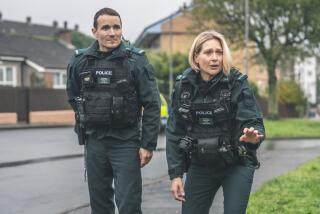In N. Ireland, Skepticism Vies With Optimism
BELFAST, Northern Ireland — In adjoining neighborhoods of northern Belfast--staunchly pro-British and Protestant White City and mostly Roman Catholic Whitewell--people were not too sure Saturday about the momentous things done in their name the previous day.
They had heard about a new assembly, and cross-border bodies, and power-sharing. All pretty abstract stuff.
“It’s the greatest thing since penicillin,” quipped a taxi driver in his 50s.
But these working-class households overlooking the choppy waters of Belfast Lough will have a handier yardstick for gauging whether peace, after 30 years, is in the offing for Northern Ireland.
Earlier this month, the government of the British-ruled province announced that relations between the neighborhoods had grown so violently hostile that it planned to spend about $250,000 to build a 20-foot-high wall of metal between them.
So, will the new peace settlement mean that the planned barrier, officially dubbed a “peace line,” will never snake across 200 yards of hillside lawns and flower and vegetable gardens to keep Protestants and Catholics even farther apart?
On Saturday, residents said they hoped that the wall will not have to be built--but many added that they believe it will prove necessary, whatever the politicians decided.
“You’re for peace, but in all the 30 years, people like us have gotten up in the morning, gone to work and been law-abiding,” Carol Smith, 47, a children’s nurse “raised in the Protestant tradition,” said as she used shears to trim the shrubs and grass in front of her three-bedroom brick duplex. “Now they’re going to let more flipping terrorists out on the street. And it’s never going to stop.”
Down the road, Geraldine Leckey, 51, a housewife and grandmother, was fielding customer calls at the Quick Cabs taxi stand as children came out of the corner grocery gobbling Easter candy.
“We Catholic people here have never been anything but second-class people--jobs, housing, rights,” the petite blond said. “I haven’t seen anything in this agreement that truly will make us true equals.”
*
Throughout Northern Ireland, people have been asking themselves and others what the agreement reached Friday by eight political parties and the British and Irish governments means for them and their future.
Skepticism is wrestling with optimism. People remember dashed hopes in the past. Others are daring to hope again. Plenty are simply confused and seeking fuller information in newspapers and from television and radio.
“I believe for the first time that this could be it--once the hotheads have sense and put down their guns,” retiree Theresa McCarron told a local reporter who went to canvass the militantly nationalistic Falls Road neighborhood of Belfast, where Irish tricolors fluttered Saturday in a cold wind that intermittently carried April snowflakes. “I would appeal to them to give peace a try. They might even like it.”
But neighbor Bernadette McMenery, whose son survived a gunshot wound to the head--making her one of the hundreds of residents of “the Falls” whose husbands, children or friends have been killed or wounded in the past 30 years of violence--was dubious.
“We’ve been told before that there was peace, and all you have to do is turn on the news and hear that another has been shot,” she said.
People here will be asked in a referendum in six weeks whether they approve or reject the proposed settlement.
On Saturday, the 110-member Executive Committee of Northern Ireland’s largest party, David Trimble’s pro-British Ulster Unionists, voted after a bitter, five-hour session to support it. Opponents denounced the deal as a sellout to the Irish Republican Army.
At least half the party’s 10 members in the British Parliament object to key clauses of the historic compromise: early releases for IRA prisoners; a role for the IRA’s political wing, Sinn Fein, in a proposed provincial assembly; and requirements that this new administration cooperate with the Irish Republic in a north-south ministerial council.
“This agreement is a disaster for unionism [keeping Northern Ireland a part of Britain],” William Thompson, one of the dissenting lawmakers, charged. “It can never be accepted.”
In 1974, a grass-roots rebellion within the Protestant majority destroyed the only other formal attempt here at sharing power with minority Catholics. So in the weeks before the referendum, proponents of this new, and much more ambitious, settlement will be trying to persuade Protestant and Catholic, pro-British or proponents of a single Irish nation, that a deal with something to displease just about everyone is, on the whole, worth it.
“If this brings peace, then that is the main thing,” said Neill Edgar, 27, who sells French fries in Belfast’s Sandy Road quarter, where lampposts and curbstones are painted in the red, white and blue colors of the Union Jack. “But no one is celebrating here yet.”
*
Speaking in support of the proposal in Washington, President Clinton vowed Saturday that the United States will continue its drive to end sectarian violence in Northern Ireland.
Clinton, who spoke by telephone with key participants in the peace talks to help overcome last-minute sticking points, said it was appropriate that the breakthrough came as Christians celebrate Easter and Jews observe Passover.
“In the last analysis, the future of that region lies in the hearts and hands of its people,” Clinton said in his weekly radio address, adding that he hopes there will be “a future rich with the lilt of Irish laughter, not the pain of bitter tears.”
A reporter for the Independent newspaper of London who went to Portadown, a fiercely unionist and 73% Protestant town halfway between Belfast and the Irish border, found that even a formal agreement will not be enough to placate some people in Northern Ireland after years of strife and centuries of polarization along religious lines.
At a pub, the journalist asked what would happen if a Catholic entered.
“He wouldn’t be walking out of here,” one patron said.
And after a peace accord?
“He wouldn’t be walking out of here.”
Troubles between White City (200 households) and Whitewell (more than three times that) began three years ago. On a sloping hillside about three miles from the shipyard where the ill-fated Titanic was built, bands of marauding youths now regularly attack each other. Rocks and gasoline bombs have been tossed into houses.
“You get a hundred of them coming up the road, and a hundred of them from the estate up above, and I’m in the middle,” said Carol Smith. “If I complain, I get a petrol bomb through the window at night.”
In both enclaves of tidy bungalows, duplexes and row houses, the “for sale” signs have gone up. There are few takers.
On April 1, authorities reported 300 “incidents,” the vast majority sectarian, since January 1997. At the same time, Adam Ingram, the province’s security minister, said the “pressing need to maintain the safety of both communities” would result in the construction of Belfast’s first major stretch of “security fencing” separating Protestants and Catholics since September 1994.
“It is my strong belief that political agreement will help us find ways of reducing sectarianism and the fear caused by it,” Ingram said in his announcement.
But, he added, “this will not be easily achieved and may not happen as quickly as all of us wish.”
*
Patrick Convery, 42, a member of a community association that includes Whitewell who is trying to multiply links with his Protestant neighbors, fumes that officialdom plans to reinforce the ghettoization that makes communal reconciliation that much harder.
“We call them community barriers. It’s a wedge driven between two communities, physical and mental,” Convery said.
The community activist views the new peace plan with a “glimmer of hope,” but he admitted that he is a congenital optimist. “If we don’t end up optimistic, we better leave and go work elsewhere, as generations have done.”
Convery draws encouragement from the fact that this year, a March 17 celebration for St. Patrick, Ireland’s patron saint, drew a few members of the Protestant community. He hopes for better attendance next year.
Up on Garton Way in White City, Samuel Graham, 16, nephew of a British army soldier, was leaning against a fence and talking with a group of other teens.
The youths denied ever having attacked Catholics, but they added that they fight back when provoked, echoing what a visitor hears in mostly Catholic Whitewell.
In the race between the “peace line” and the peace agreement for Northern Ireland, Graham said he believes the fence will prevail.
“You can’t please both sides,” the teenager said. “Please the Prods [Protestants] and the Catholics are going to start. Please the Catholics and the Prods will start. It can never be fixed. This country, I figure, will end up in civil war.”
*
* BLAIR COLLECTING PLAUDITS: In the wake of the peace deal, acclaim is mounting for British Prime Minister Tony Blair. A13
More to Read
Sign up for Essential California
The most important California stories and recommendations in your inbox every morning.
You may occasionally receive promotional content from the Los Angeles Times.










